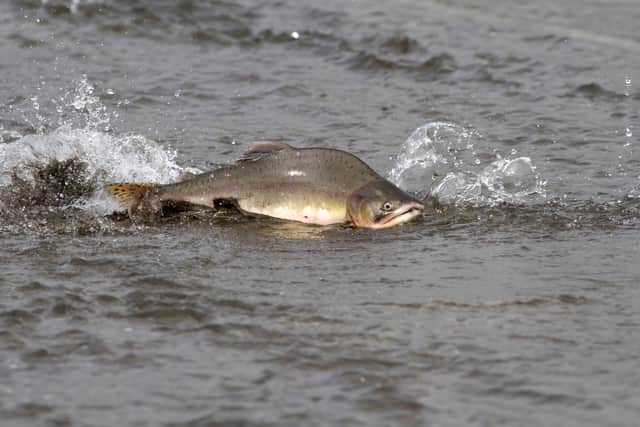Warning to report ‘crucial’ sightings of ‘invasive’ pink salmon in UK waters
and live on Freeview channel 276
It is “crucial” the public reports sightings of a “non-native species” of fish in UK rivers, the Environment Agency (EA) has warned.
The government body is calling on the public and anglers to look out for pink salmon in UK waters and understand the “immediate risk” the species pose.
Advertisement
Hide AdAdvertisement
Hide Ad“Invasive” Pacific pink salmon is expected to appear in English rivers and coastal waters this year raising potential concerns to other native species including wild Atlantic salmon.
Atlantic salmon are already a threatened species as numbers have fallen dramatically due to various pressures - and the invasive pink salmon is an additional threat to their survival.
Pink salmon can be identified by large black oval spots on their tail, a very dark mouth and tongue and have much smaller scales than the Atlantic salmon. There were numerous sightings of the species in UK waters in 2019 and 2021.
Fisheries managers, anglers, net fishers and members of the public are being urged by the EA to report any sightings or catches to the national hotline on 0800 80 70 60. A new online reporting tool can also be used to report any sightings or captures of pink salmon.
Advertisement
Hide AdAdvertisement
Hide Ad

Simon Toms, National Fisheries Management Team Leader at the EA, said: “Environment Agency teams are working hard to contain and control invasive non-native species so that native fish, ecosystems and other wildlife are reduced from the damage they pose.
“That is why it is crucial that the public understand this immediate risk and report the capture or sightings of all pink salmon to us, whether that be through our new reporting tool or to the EA’s national hotline.”
The EA added that “no notable disease or novel parasites have been detected on pink salmon” but “we need to remain vigilant” and “continue to investigate the possible risk of undesirable consequences arising from the presence of this invasive species.”
It added that spawning activity is likely to occur in late July, August and September “particularly in shallow, gravelly glides and runs” and “any suspected activity should also be reported to us as soon as possible.”
Advertisement
Hide AdAdvertisement
Hide AdIf members of the public capture or spot a pink salmon, they are being asked to collect and report details including the date of the capture or sighting, the location and details of the site, the method of capture and if caught, the sex of the fish.
Pink salmon have a distinct two year life cycle and stocks of the fish can be distinguished by their year of return. Some return in “even” years and others return in “odd” years.
Russian and Norwegian pink salmon are derived from “odd-year” stocks while all of the reports in England have occurred in “odd” numbered years. The EA said it is “therefore highly likely that we will see increased reports of pink salmon in English rivers and coastal areas in 2023.”
Comment Guidelines
National World encourages reader discussion on our stories. User feedback, insights and back-and-forth exchanges add a rich layer of context to reporting. Please review our Community Guidelines before commenting.
